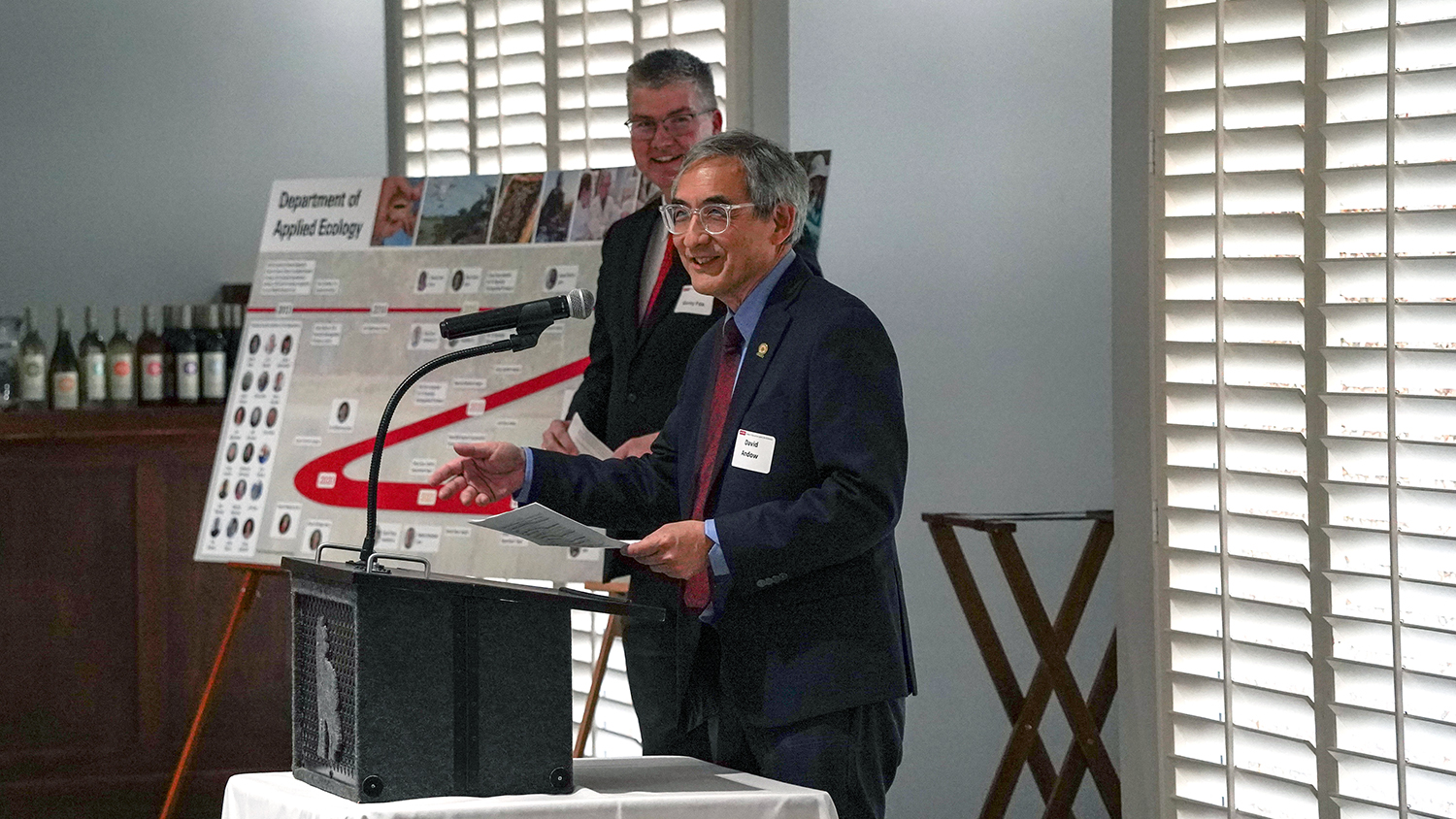NIFA chief delivers wide-sweeping seminar on challenges facing 21st century agriculture
Calling a booming world population “the mother of all wicked problems,” National Institute of Food and Agriculture Director Sonny Ramaswamy called upon an NC State University audience to press forward in delivering on the promise of biophysical and social sciences to ensure food security for a population expected to reach 9 billion by 2050.
Ramaswamy, who was at NC State to take part in the two-day Agriculture and Biotechnology Summit earlier in the week, led a seminar for students and faculty and staff members on Thursday, Nov. 20, at the Talley Student Center. Sponsored by the North Carolina Cooperative Extension Service as part of its centennial celebration, Ramaswamy’s talk was titled “Setting the table for a flatter, hotter, more crowded Earth.”
“I know that we have the ability to roll our sleeves up and lick this challenge,” he said. “We’ve got to.
“It is incumbent on the people assembled here at North Carolina State University and other institutions across America – across the globe. for that matter – to make those transformative discoveries, whether they be in the biophysical realm or the social sciences realm …, that deliver on the promise of ensuring food security for the entire world.”
Doing so won’t be easy, he said, because the population growth creates a number of “baby wicked problems” related to food, water, the environment, climate change, energy and health.
Many constraints confront those working to address the problems – not just biological and non-biological constraints in the environment but also constraints created by disagreements about how best to resolve the problems.
Even with transformative scientific solutions available, there are “human dimensions, sociological dimensions” that are critical, Ramaswamy said. “You have people involved, and they start butting heads, and when you start butting heads, nothing gets done.”
In the area of agricultural systems, he noted several challenges, including agriculture’s environmental impacts, which, in turn, affect agriculture itself; an increasing demand for biologically-based products to replace petroleum products; and health problems created by people’s food choices.
Ramaswamy particularly emphasized the importance of competitiveness. With the average American farmer’s age at 58 today and climbing, the world needs to find ways to make farming a competitive enough career for young people to want to enter.
A competitive 21st century agricultural system will depend in part on what Ramaswamy called “the internet of agicultural things” – things such as robots, unmanned aerial vehicles and sensors – that will allow for “smart farming.”
“I’m not talking about the precision agriculture that your daddy or your brother or sister is doing today with GPS in their combines,” he said. “I’m talking about … biological and mechanical sensors on plants” that signal to farmers using hand-held devices when the crops need additional nutrients or when there are weed, disease or insect problems.
He also talked about the need for scientists and Extension professionals to make advancements to curb food waste. Calling the issue “low-hanging fruit,” he noted that while developing countries lose almost half of their food before it gets to the dinner table, in developed countries, almost half of the food is lost after it’s produced.
“The Economic Research Service tells us that in the United States, we are basically dumping 131 billion pounds of food per year – with a ‘b’ – and that translates into 1,200 calories per man, woman and child per day,” Ramaswamy said. “For the average adult to thrive, they need 2,200 calories. … So 1,200 is more than half of (what we need in terms of caloric value.”
Not only does wasted food mean less food to feed the growing population, it also means that more is going to landfills, where it releases greenhouse gases, Ramaswamy said. And wasted food also means wasted water, which is already becoming a scarce resource.
Waste happens not only in transportation and storage, but in grocery stores, restaurants and homes. “So everybody needs to get into this act,” he said. “If we are wasting half, losing half right now, what if … our Extension folks went out and started talking about this?”
While Extension can help people learn ways to cut back on food waste, Ramaswamy said, researchers can look at ways create new waste-reducing technology such as refrigerators that let consumers know when their food is reaching expiration dates and shrink wraps that change colors to indicate when food is going bad.
Ramaswamy concluded by noting that if the U.S. agricultural system does nothing to address the challenges posed by a growing world population, “we are going to have malnutrition and hunger” that can spur riots and wars.
“The clock is ticking,” he said. “And it’s important for us to address this challenge. We have to do it right now, in the next few years.”
-Dee Shore


